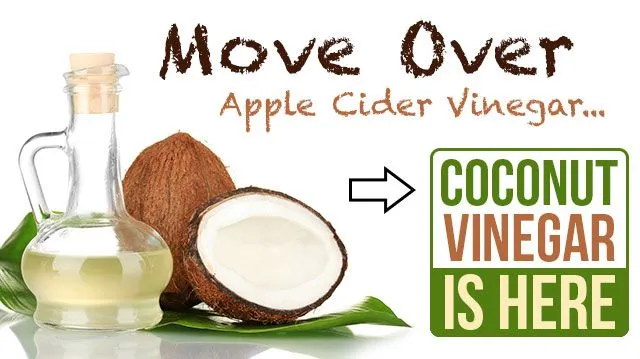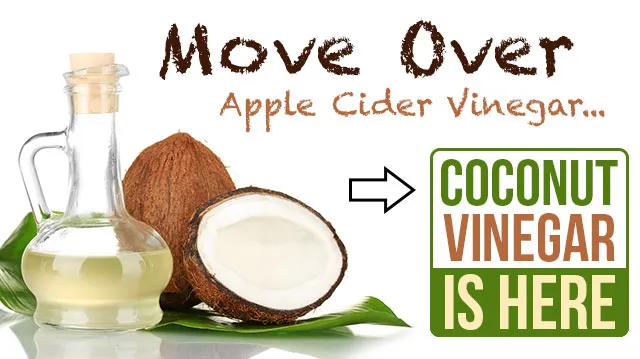
- Share on Facebook336
- Share on Pinterest
- Share on Twitter
Move over apple cider, you may have met your match in the vinegar world. Introducing coconut vinegar. I have to admit, I had never tried coconut vinegar before now. I love, love, love coconut oil and use it daily. I cook with coconut sugar and coconut flour, and drink coconut water… but coconut vinegar is entirely new to me.
So, I did expect it to taste a bit like coconuts, but it actually tastes like a milder version of apple cider vinegar with a hint of sweetness. It doesn’t have that “knock your socks off” burn that you get with apple cider vinegar, but rather has a nice mild and highly palatable taste.
How is raw coconut vinegar made?
Cheap rip-off imitations of the real thing use coconut water and are often less expensive than coconut vinegar made from coconut nectar, also known as purong tuba. Regarded as the “Champagne of Vinegars,” coconut vinegar made from coconut flower nectar is insanely nutritious and has a unique taste that is far beyond vinegars made with diluted coconut water.
To make coconut vinegar, the flowering stems of the coconut blossom are tapped to yield coconut nectar. Fermentation takes anywhere between 45–60 days. After this, the unfiltered and unheated vinegar is bottled. As the vinegar ages, its color changes from white to a light yellow, and then to a clear brown as it matures.
The “mother”
We have talked a lot about the “mother” found in apple cider vinegar. Well, raw coconut vinegar actually contains a similar live body. The cloudy and somewhat cobweb-like structure that you see at the bottom of the bottle is endearingly referred to as the “mother” because of its life-giving properties.
As the vinegar ages, the mother becomes more pronounced, and if you hold the vinegar bottle to the light you can almost always see the makings of the mother — usually suspended close to the bottom of the jar. In the mother are valuable nutrients and beneficial bacteria that make unprocessed coconut vinegar so special.
Health benefits of raw coconut vinegar
Just like its rival, apple cider vinegar, coconut vinegar has some tremendous nutritional benefits that make this vinegar shine!
It contains 17 amino acids
Coconut sap contains all of the nine essential acids and more. These essential acids are the building blocks of protein, and since proteins are a component of every living cell inside your body, they are pretty important. Amino acids are also necessary for the production of hemoglobin, which transports oxygen, and the formation of antibodies which keep your immune system functioning as it should. In addition, amino acids help to repair tissue, assist in both detoxification and metabolic functions and serve as neurotransmitters, conveying messages in the brain.
It is loaded with minerals
Coconut trees are generally grown in rich volcanic soil that contains abundant minerals. Within the sap itself you will find the following minerals: potassium, iron, magnesium, sulfur, boron, manganese, zinc and phosphorus. Raw coconut vinegar is especially impressive in the amount of potassium it contains — a whopping 192 milligrams per tablespoon. Potassium is necessary for balancing electrolytes, managing high blood pressure and metabolizing sugar.
Phosphorus pairs with calcium to build strong bones and plays a critical role in the body’s ability to use other nutrients. Of course, iron is needed for the creation of red blood cells and cellular energy, and copper helps with iron absorption. Magnesium is essential in nerve and muscle function, along with playing a role in just about every major biological process in the body.
It is high in vitamin C
Vitamin C (ascorbic acid) is an antioxidant that is required for three hundred metabolic processes in the human body, including tissue growth and repair, adrenal gland function and healthy gums. Vitamin C also aids in the production of anti-stress hormones, and interferon — a vital immune system protein. It is needed to metabolize folic acid, tyrosine, and phenylalanine.
It contains broad spectrum B vitamins
Coconut vinegar is an excellent source of B vitamins, which are essential for a variety of metabolic functions in the body and are especially key in nervous system function.
It has a neutral pH
Disease actually comes from within and is the result of poorly balanced blood chemistry. We have become an overly acidic nation by consuming highly processed foods and very few healthy, alkalizing foods. An acidic body is vulnerable to germs, and even though our internal systems fight to keep an alkaline environment, they become overwhelmed and chaos ensues.
Proper diet is the only way to keep a healthy acid/base balance — there is no other way. Since food is the fuel for the body, it is wise to spend some time thinking about just what we fuel our bodies with.
Over-acidity is, for the most part, a result of the choices we make. With this understanding, we can begin making good choices at any time. Rebalancing the body is like getting a second chance. Catching the signs of imbalance early makes it easier to regain health — before organs begin to fall apart.
Understand that if you suffer from such things as chronic pain, headaches, irritability, fatigue, allergies, sinus problems or mental fogginess, your body is giving you a clue. The first step in balancing body chemistry is fueling the body with alkaline foods.
It is enzyme rich
When it comes to good health, digestive enzymes are a necessity. Simply put, digestive enzymes break down food so our body can use it. If we are lacking in digestive enzymes (which most of us are), we lose the nutritional value of any food we eat. Because most people eat more cooked and processed food than raw food, many of the enzymes are destroyed. Adding even just a little bit of raw coconut vinegar to your diet can help tremendously with digestive health and immunity.
 It contains prebiotic FOS
It contains prebiotic FOS
Prebiotics are nutritional fibers that cannot be digested by the human digestive system. They are complex chains of sugars that travel through the stomach and small intestine 90 percent whole and arrive in the large intestine, where they serve as food for probiotic bacteria.
There are two main types of prebiotic fiber: fructo-oligosaccharides (FOS) and galacto-oligosaccharides (GOS). Inulin is one of the most commonly known prebiotics and belongs to the FOS group. The other most promising type of prebiotic is oligofructose.
One of the main benefits of prebiotics is their ability to feed desirable probiotic bacteria. This is done through a fermentation process. Many types of bacteria are able to ferment and metabolize prebiotic fiber, but lactobacilli and bifidobacteria in particular have been observed to thrive on prebiotics. You may recognize those species from the back of a yogurt container or probiotics supplement label. These are two of the main species that help us to digest food properly and excrete what’s left over as waste.
Prebiotics were first identified by scientists in 1995, and since then many studies have been performed to evaluate their therapeutic effects. In studies where people consumed prebiotics, it was observed that their gut microbiome shifted toward containing more beneficial bacteria and fewer pathogens (disease-causing microorganisms).
This shift toward a healthier microbiome can create many benefits in the human body.
Scientists have found that using prebiotics increases the ability to absorb minerals such as calcium and magnesium. Magnesium, in particular, is lacking in the diet of a large percentage of the population.
Prebiotics are also able to strengthen immune function enough to combat recalcitrant bacterial conditions such as bacterial vaginosis, recurrent urinary tract infections, pertussis, pneumonia, and H. pylori.
It is low glycemic
One of the really nice things about coconut vinegar is that it is incredibly low on the glycemic index — only 35 on the scale. The glycemic index measures how much a carbohydrate-containing food raises blood sugar. While there are many foods on the market with hidden sugar that rate high on the glycemic index — including things like salad dressing — the good news is, coconut vinegar is not one of them.
Ways to use this nutritionally rich tonic
Because I am a salad lover, I went straight for using coconut vinegar for salad dressing, and it was amazing. This versatile vinegar can also be added to sauces and condiments, or used for cooking and dipping. You can also take one or two tablespoons medicinally in a cup of warm water with a touch of honey.
Be sure that you purchase only raw organic coconut vinegar with no additives.
There you have it — another gift from the coconut palm. This tree is utterly amazing and loaded with health-promoting properties. The next time you are looking for something new and exciting to add to your salad, or simply to better your health, try raw coconut vinegar.
Click here for 9 Reasons to EAT Coconut Oil Every Day (#3 is shocking)
—Susan Patterson
Susan is the Content Director at The Alternative Daily, a Certified Health Coach, Certified Metabolic Typing Advisor and Master Gardener. With an extensive knowledge of whole foods and wellness, Susan enjoys educating others on how to live healthy and sustainable lives. She presently lives off grid in the middle of the New Mexican high desert with her three children and numerous animals.
- Share on Facebook336
- Share on Pinterest
- Share on Twitter

